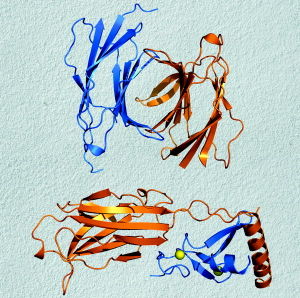CZ:Featured article/Current: Difference between revisions
imported>Chunbum Park m (moved CZ:Featured article/Tecum Umam to CZ:Featured article/Current over redirect) |
imported>Chunbum Park (macromolecular chemistry) |
||
| Line 1: | Line 1: | ||
{{Image| | {{Image|Muncprotein.jpg|right|300px|Inman M ( ) Shape of a common protein module suggests role as molecular switch.}} | ||
'''[[Macromolecular chemistry]]''' is the study of the physical, biological and chemical structure, properties, composition, and reaction mechanisms of [[macromolecules]]. A macromolecule is a molecule that consists of one or more types of repeated 'building blocks'. The building blocks are called [[Monomer|monomeric unit]]s (monomers). | |||
Macromolecules (also known as polymer molecules) appear in daily life in the form of [[plastic]], [[styrofoam]], [[nylon]], etc. These [[polymer]]s, i.e., substances consisting of polymer molecules, are of great technological importance and are used in the manufacturing of all sorts of goods, from automobile parts to household appliances. The artificial polymer molecules usually exist of long repetitions of identical monomers, either in chains or networks. | |||
In molecular biology macromolecules (biopolymers) play a very important role: the well-known molecules [[DNA]], [[RNA]], and [[polypeptides]] ([[proteins]]) are examples of macromolecules. In molecular biology one is mostly interested in macromolecules in solution, usually dissolved in water. The biological function of macromolecules in living cells is a highly relevant and widely studied topic of research. Although, strictly speaking, biopolymers belong to the class of polymer molecules, there is a tendency not to use the latter name in biological applications, but to speak of macromolecules. The term "polymer" is usually reserved for the substances manufactured in bulk by the chemical industry. | |||
In industry, the value of synthetic macromolecules as plastics and nylon, has risen enormously over the last 60 years. They have made it possible to mould shapes that would have been impossible to create without them. When they were first developed, their resistance to rupture and degradation was seen as a profound advantage, but nowadays we seek more biologically degradable plastics such as polyethyleneglycol that pollute the environment less. | |||
Biological macromolecules include, besides the molecules already mentioned, [[enzyme]]s, and [[polysaccharide]]s, such as cellulose and starch. The better understanding of the basic behavior of polymer molecules has enhanced our knowledge of these biological molecules, and studies of partially charged [[polyelectrolytes]] have led to a deeper insight into their biological function. The investigations of the three-dimensional structure of macromolecules, (their [[configuration]] and [[conformation]]), have led to the identification of specific regions that perform specialized activities. A good example is the catalytic role of particular amino acid residues in polypeptide enzymes and the role of [[functional group]]s such as [[biotin]] or [[riboflavin]] in cellular metabolism. The folding of macromolecules is now a topic of much scientific investigation, since the correct folding of these polymers is a critical factor for normal function. Abnormal folding of particular proteins is the cause of several diseases, including [[Alzheimer disease|Alzheimer's]] and [[Creutzfeldt-Jakob disease]] (CJD) . | |||
Revision as of 12:55, 27 May 2011
Macromolecular chemistry is the study of the physical, biological and chemical structure, properties, composition, and reaction mechanisms of macromolecules. A macromolecule is a molecule that consists of one or more types of repeated 'building blocks'. The building blocks are called monomeric units (monomers).
Macromolecules (also known as polymer molecules) appear in daily life in the form of plastic, styrofoam, nylon, etc. These polymers, i.e., substances consisting of polymer molecules, are of great technological importance and are used in the manufacturing of all sorts of goods, from automobile parts to household appliances. The artificial polymer molecules usually exist of long repetitions of identical monomers, either in chains or networks.
In molecular biology macromolecules (biopolymers) play a very important role: the well-known molecules DNA, RNA, and polypeptides (proteins) are examples of macromolecules. In molecular biology one is mostly interested in macromolecules in solution, usually dissolved in water. The biological function of macromolecules in living cells is a highly relevant and widely studied topic of research. Although, strictly speaking, biopolymers belong to the class of polymer molecules, there is a tendency not to use the latter name in biological applications, but to speak of macromolecules. The term "polymer" is usually reserved for the substances manufactured in bulk by the chemical industry.
In industry, the value of synthetic macromolecules as plastics and nylon, has risen enormously over the last 60 years. They have made it possible to mould shapes that would have been impossible to create without them. When they were first developed, their resistance to rupture and degradation was seen as a profound advantage, but nowadays we seek more biologically degradable plastics such as polyethyleneglycol that pollute the environment less.
Biological macromolecules include, besides the molecules already mentioned, enzymes, and polysaccharides, such as cellulose and starch. The better understanding of the basic behavior of polymer molecules has enhanced our knowledge of these biological molecules, and studies of partially charged polyelectrolytes have led to a deeper insight into their biological function. The investigations of the three-dimensional structure of macromolecules, (their configuration and conformation), have led to the identification of specific regions that perform specialized activities. A good example is the catalytic role of particular amino acid residues in polypeptide enzymes and the role of functional groups such as biotin or riboflavin in cellular metabolism. The folding of macromolecules is now a topic of much scientific investigation, since the correct folding of these polymers is a critical factor for normal function. Abnormal folding of particular proteins is the cause of several diseases, including Alzheimer's and Creutzfeldt-Jakob disease (CJD) .
